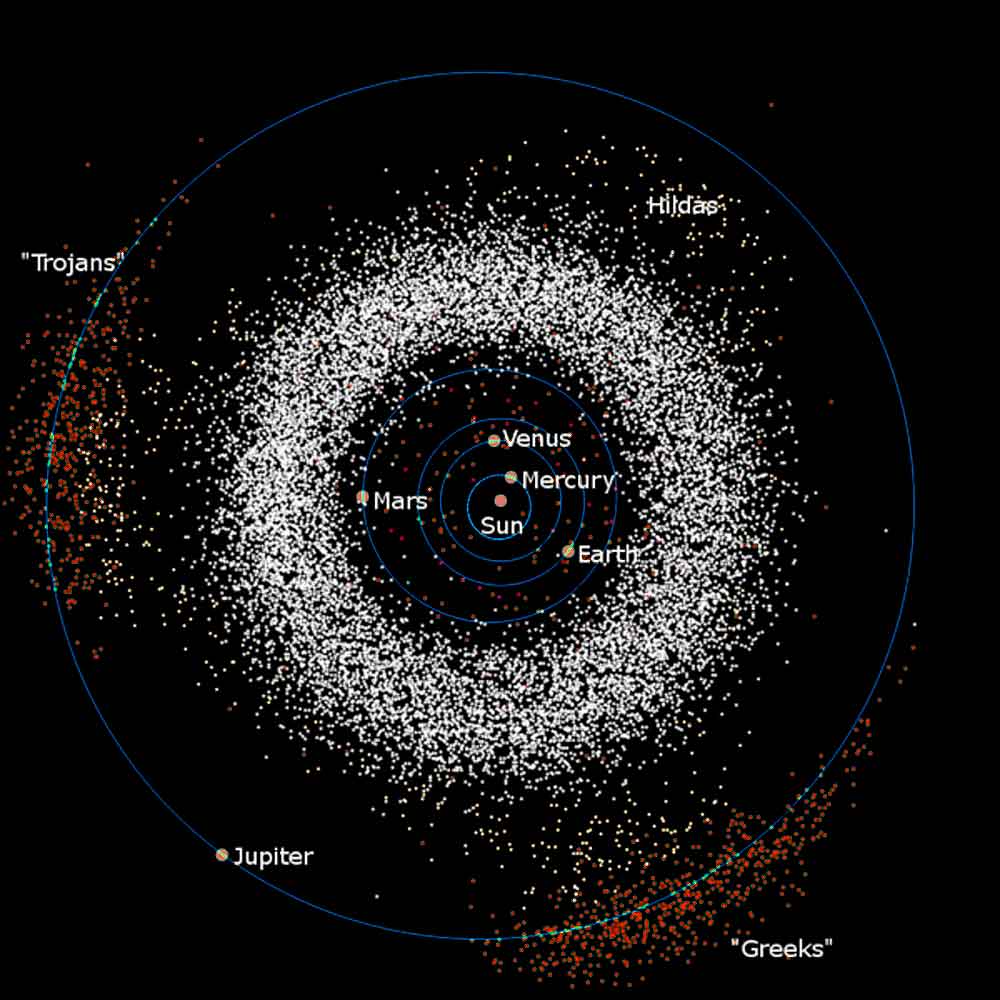Asteroids are the most diverse bodies in the solar system, some are tiny, some are periodic, others have a very long day. In this article we have compiled information about some of these types

Tiny asteroids
Tiny asteroids are bodies with an average diameter of tens of meters that orbit the Sun and some of them during their movement pass by the Earth. In fact, until 1998 there was no information about them. Such a body was observed for the first time during an observation conducted between 2.6-8.6.1998. In this observation, the passing body is seen at a distance of 800,000 km from the Earth. This body was named 1998KY26. The analysis of the observation showed that it is a spherical body with a diameter of 30 meters that rotates around itself once every 10.7 minutes. In its composition, it is made of carbonate chondrites and 10-20% water. It is believed that its spherical shape is the product of a collision with other asteroids (1).
In 2000, an asteroid named 2000DO8 was discovered that revolved around itself once every 78 seconds, in 2008 another asteroid was discovered that was named 2008GP3 and revolved around itself once in 11.8 minutes. On April 29.4.2008, 1, another asteroid was discovered that passed 2008 million km from Earth. The asteroid was named 24HJ and its dimensions are 12 x 42.7 meters. It rotates around itself once in 2 seconds (XNUMX).
It is estimated that most of these bodies were formed during a collision with larger bodies. It is also possible that some of the tiny asteroids were formed during the formation of the solar system. It is also possible that tiny craters with a diameter of tens and hundreds of meters on the surface of the planets and their moons were formed due to the impact of such tiny asteroids (the hypothesis of the writer-Haim Mezar).
Sources
1. "Sun never sets, for long, on fast-spinning water rich asteroid" 22.7.1999
http://echo.jpl.nasa.gov/
2. "Amateur astronomer discovers fastest rotator in the solar system" 29.5.2008
http://www.spacedaily.com/reports/ Amateur _Astronomer _Discovers_Fastest _Rotator _In _The _Solar _System_999.html
Asteroids with very long days
Asteroids with a very long day are asteroids that rotate around themselves once every few days, very slow rotation speed around themselves. To date, two such asteroids have been observed and they are:
1999JM8
This asteroid was first observed in 1990 and was given the name 1990HDI and on 13.5.1998 it was rediscovered when it passed at a distance of 8.5 million km from the Earth and was given the name 1999JM8. It is 3.5 km long and cracks and craters were found on its surface. Some of the craters are hundreds of meters in diameter and some are larger than 800 meters in diameter. The photographs are radar photographs with a resolution of 15 meters per pixel. The asteroid rotates around itself once a week. It is not clear why the rotation speed is so slow. It may be the product of different asteroid impacts from different directions that slowed its axial rotation speed.
Sources
1. "Two extreme asteroids" Sky and Telescope 12/1999 p. 26
2. "Radar images capture large, slowly tumbling asteroid" 26.8.1999
http://neo.jpl.nasa.gov/images/1999jm8.html
3. "Images of asteroid that crossed Earth's orbit show strange world" 27.8.1999
http”//explorezone.com/archives/99_08/27_asteroid.pic.htm
Tautatio
This asteroid was discovered in 1982. In December 1992, it passed at a distance of 4 million km from the Earth and radar photographs were taken of it. It seems that these are two bodies that stuck together during a collision. The length of one body is 4 km and the other 2.5 km. Craters can be seen in both. The asteroid has two rotation cycles around itself, one of 5.4 days and the other of 7.3 days.
מקור
Tautatio-http;//lasco2.mpae.gwdg.de/solar/eng/toutatis.htm
